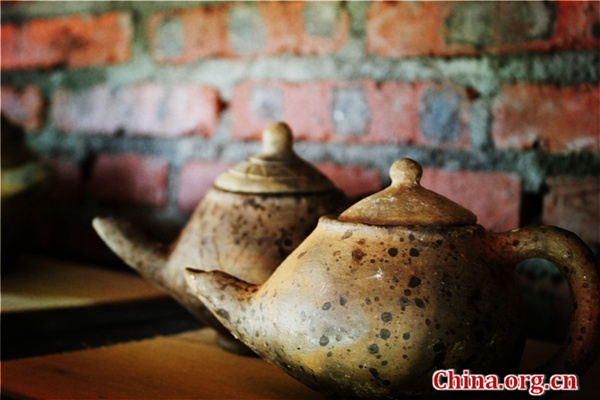
Two teapots sit on the shelf of the museum of pottery of Li ethnic group located in Baotu Village of southern China's Hainan Province. (Photo/China.org.cn)
With a willow branch in the left hand and a ceramic pot containing water in the right, Grandma Yang sprinkled water towards a flaming bonfire. In her black costume with various colorful knitting decorations stitched on it, she and a few other women circle the bonfire, murmuring some words from their native dialect.
This was a scene of praying for high-quality pottery during afiring at a pottery museum and workshop in Baotu Villageof southern China's Hainan Province on Nov. 14. Grandma Yang (full name Yang Bailiang) is a pottery-making master of the Li ethnic groupin this village.
Located by the Changhua River in Changjiang, the villageis the birthplace of Li pottery manufacturing. This minority nationality, regarded as the indigenous people here, has been passing on a unique culture and thecraft of pottery making for an estimated six thousand years.
Time-honored and unique craft
The history of Li pottery can actually be traced to the Neolithic Age when they first acquired use as pots for heating up food or utensils containing water. Its ancient heritage explains the pristine flavor imparted, stemming from its special manufacturing technique.
Different from the modern way of making pottery by using a machine or kiln, the Li continue to follow an ancient way bordering on the most primitive.
Grandma Yang, an inheritor of the craft, is now in her 70s. At the workshop, she displayed the procedures together with several other Li women: expertly piling up clay strips with their hands, toning the unfired semi-pottery byhand, bambooboards and shells, and then firing them on a bonfire in the open air.
Actually, the complete manufacturing process follows a series of 12 steps includingexposure to the sun and filtrating the clay. The wares made with this craft, despite their rough surface and dim luster, acted as useful items in daily life for thousands of years, and tell theLi history along with the ancient lifestyle and culture of the Li people to the modern world.
"I saw from thousands of years of unique culture of the ethnic group a completely different Hainan,"said Zhou Yuxin, a journalist from Shaanxi Province,after viewing the pottery firing and the accompanying prayer ceremony.
New vitality in the new era
With various modern techniques of pottery productioncreated, and more useful utensils springing up, demand for the old clay pottery is rapidly declining, and this ancient way of pottery making is seemingly becoming obsolete.
However, instead of fading away due to infrequent use in modern life, people came to recognize and discover the time-honored cultural valuewithin these clay wares, and made efforts to renew the vitality of the ancient craft and the cultural vitality of the Li ethnic group.
When the staff of Changjiang Cultural Center came to seeGrandma Yangone day in 2005 and told her that the craft she had inherited was to be the subject of an application for recognition as a National Intangible Heritage, she had no idea what that meant for the craft she had inherited and had been living on; however, she and her family knew for sure that it was something good.
Under the promotion of the Changjiang government and the perseverance of the craft inheritors in maintaining traditions, the pottery manufacturing craft of the Li ethnic group wasacknowledged as a National Intangible Heritage in 2006.
In 2013, a professional cooperative was established to get more people involved to ensure inheritance of the craft. Two years later, the pottery museum and workshop rose and began to embrace residents and tourists, presenting them not only with Li pottery wares, but also the pottery manufacturing and firing.
The DIY activities now enjoy widespread popularity among the tourists in particular.
The membership of the cooperative increased from seven to 38 in only three years, and Grandma Yang and a few other pottery craftspersonages also taught over 200 women in the village. With these efforts, the ancient craft managed to keep pace with the tide of modernity rather than dying out, and more and more peoplecame to know and began to learn the manufacturing techniques. However, it didn't stop there.
"We should grant Li pottery a tangible flavor of everyday life and the vitality for them to be more than intangible heritage," said Liu Meizhen, person-in-charge of the pottery workshop, while pointingout to visitors a few ceramic kettles on the shelf of the workshop. With a four-digit number on each, kettles like these are now being used in some of Hainan's major hotels as "doorplates,"so that Li pottery is again adopted in practical waysas before and visitors here can get easy access to them as well.
From female inheritors exclusively to both genders
October 2016 was a historical time for the ancient craft when Grandma Yang accepted three young men of the Li ethnic group as her apprentices.
What made this move unusual was that, since the craft of Li pottery making originated from a matriarchal clan society, theethnic group actually had been passing on the craft of pottery making solely among femalesuntil Grandma Yang broke the routine and aimed to bring new vitality to the inheritance and development of the ancient craft.
Now, not only are there male inheritors, but tourists can get access to the craft and make their own pottery wares under the guidance of the pottery professionals at the workshop.
Impressed by the pristine beauty of the pottery and the craft involved, Deng Zhongjiu, a visitor from Zhejiang Province standing by the bonfire, declared: "Now I know that Hainan has not only the sea, but also its unique culture."


















































